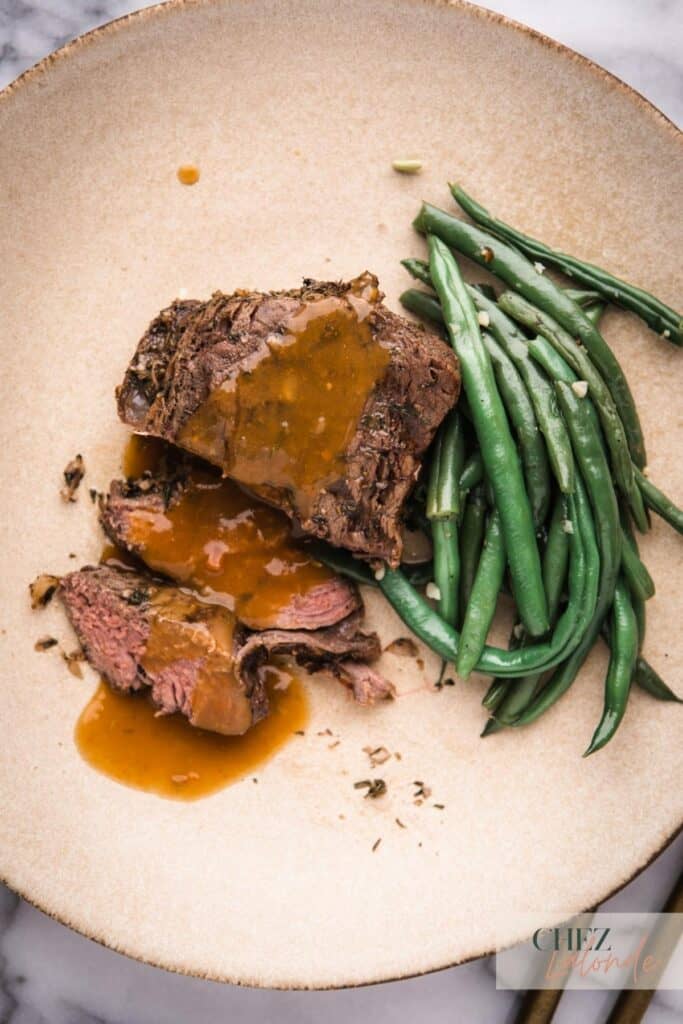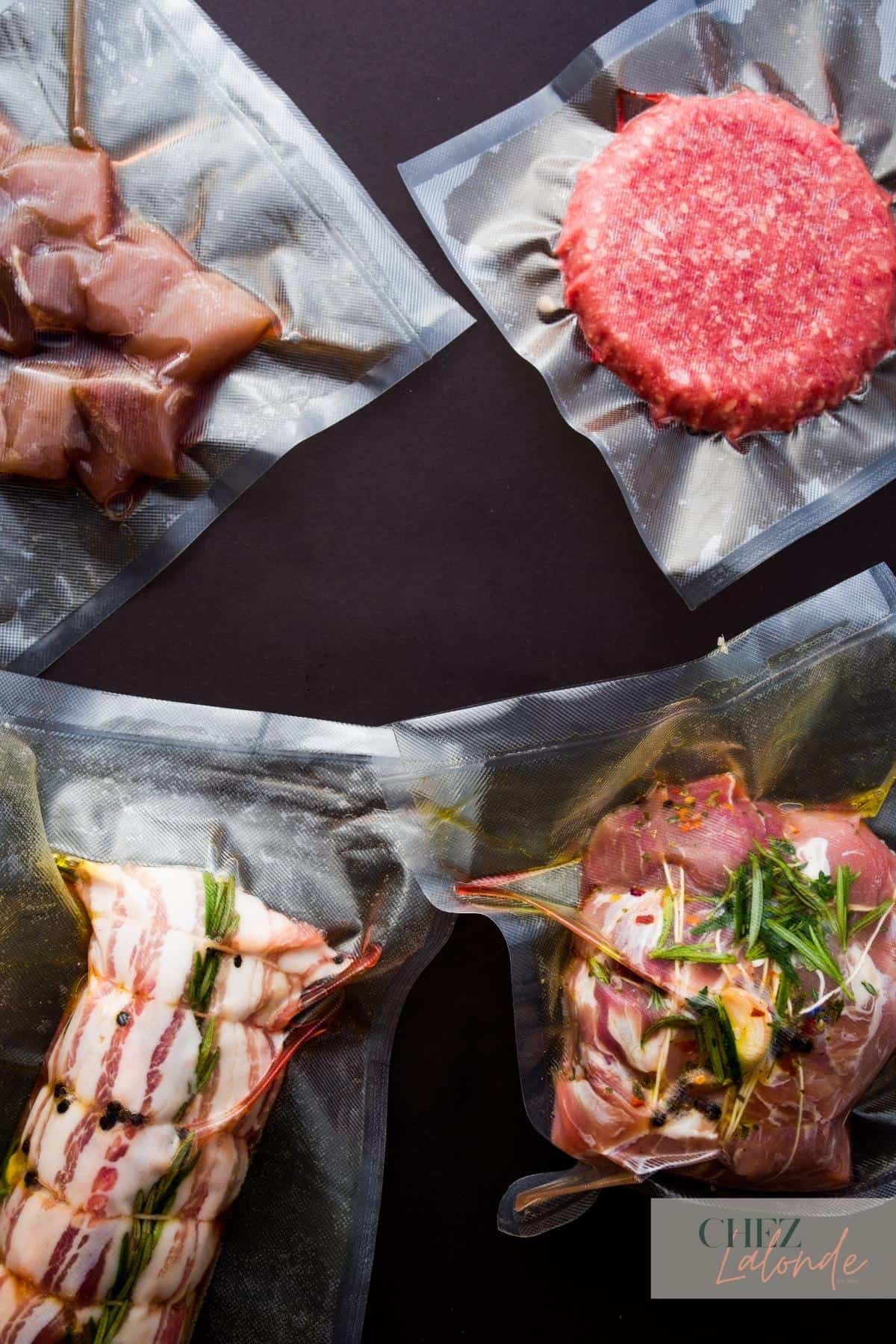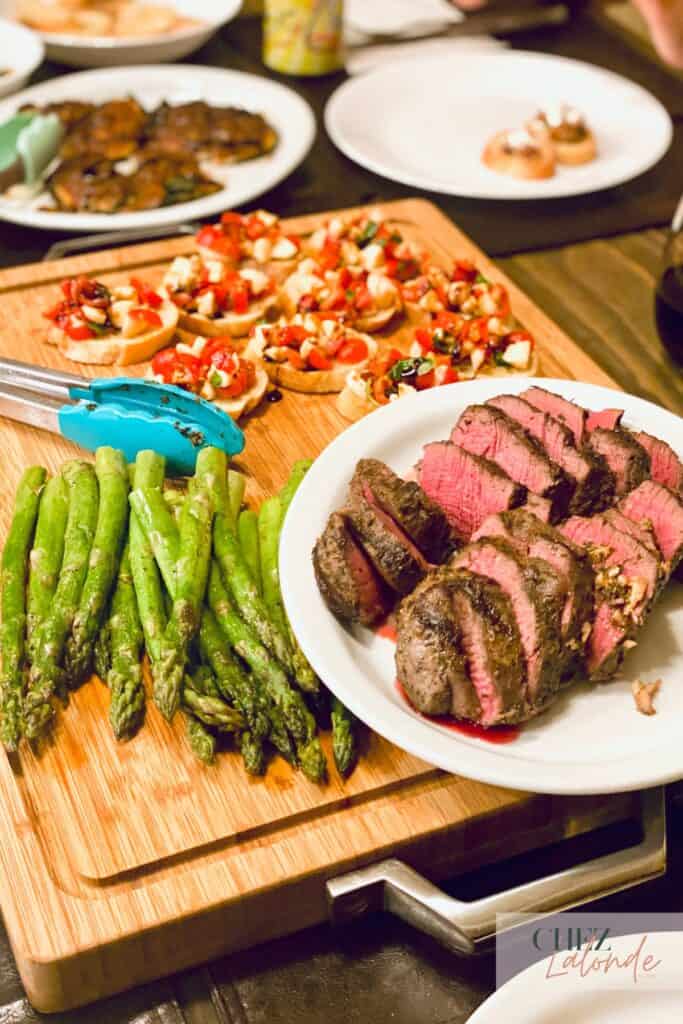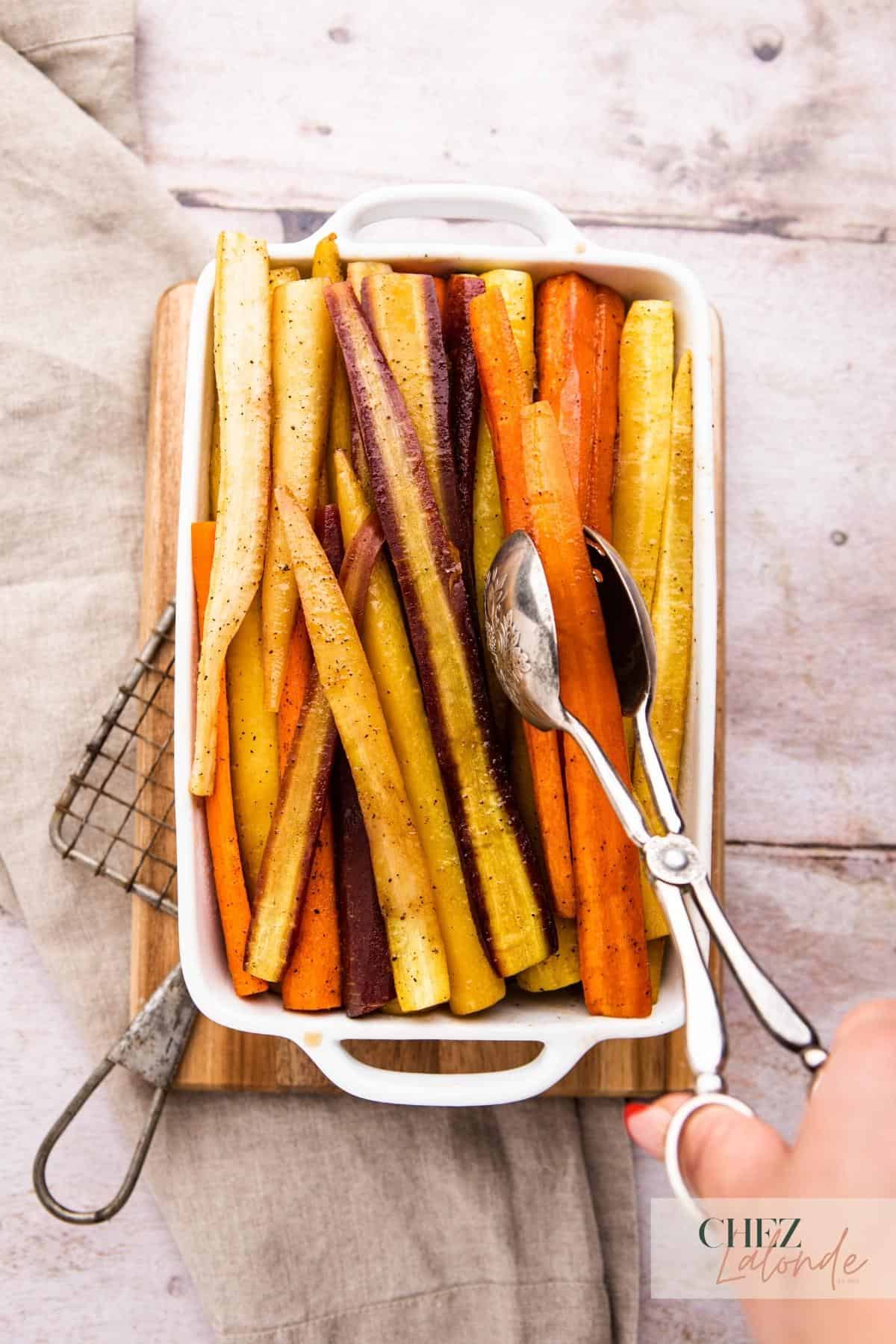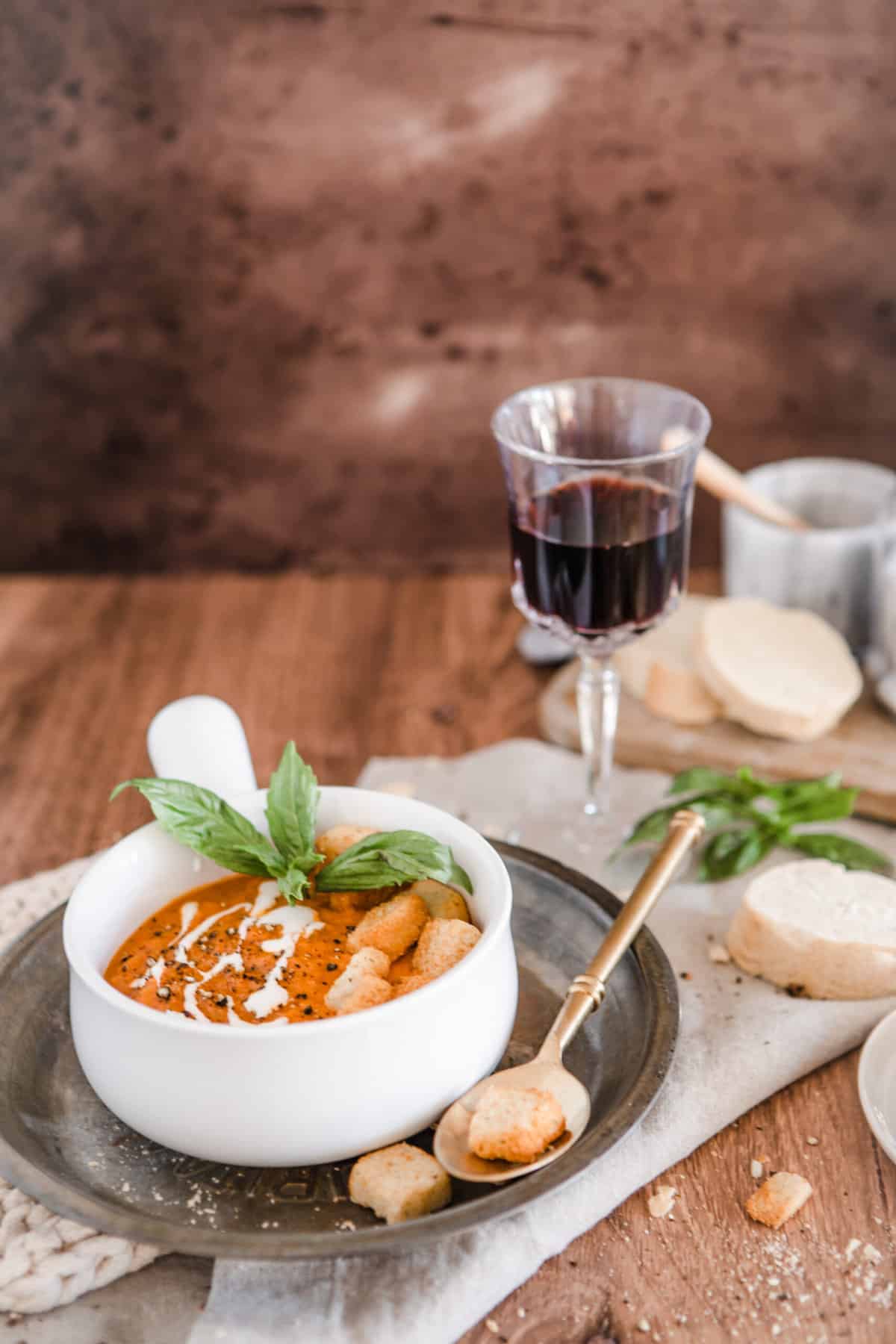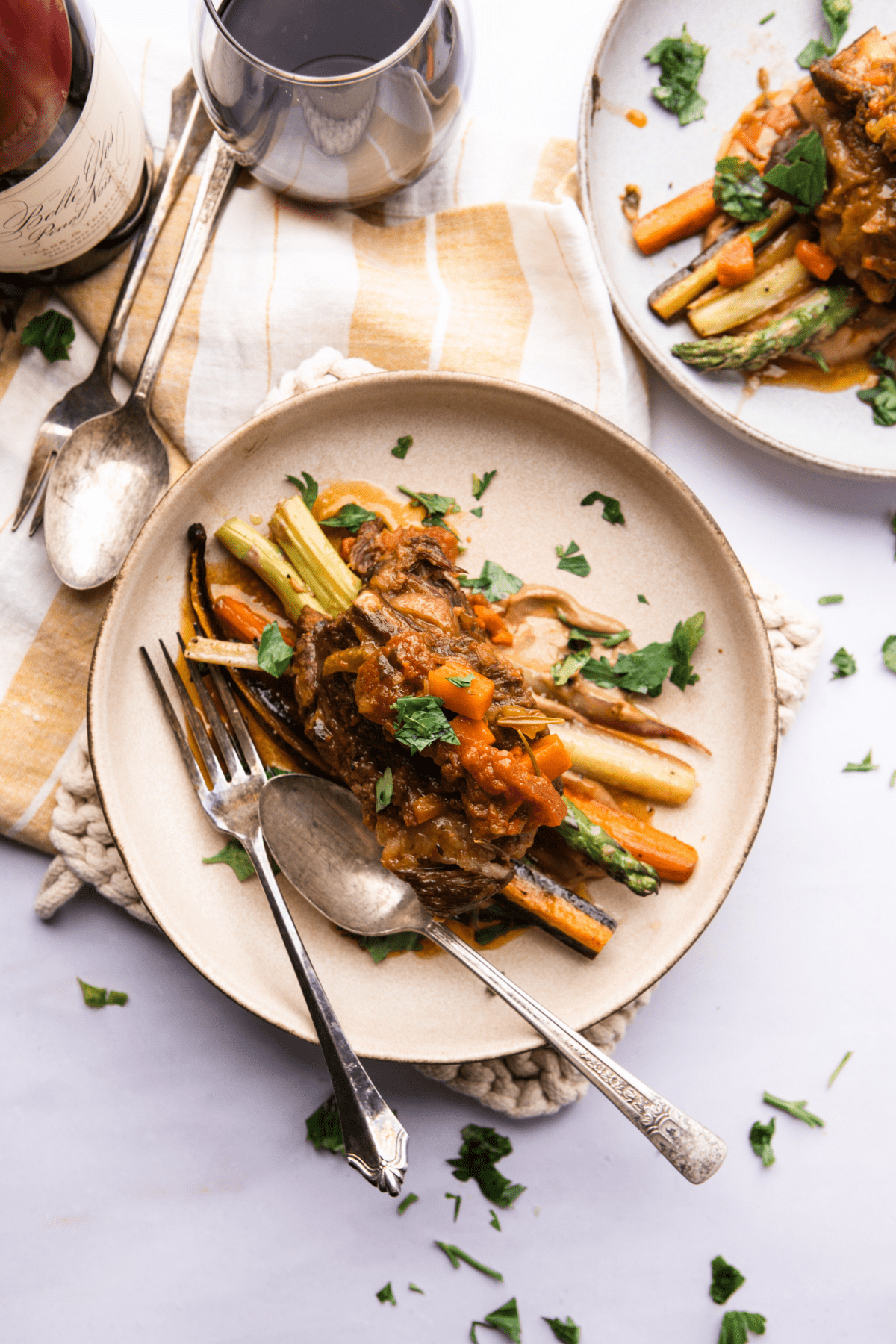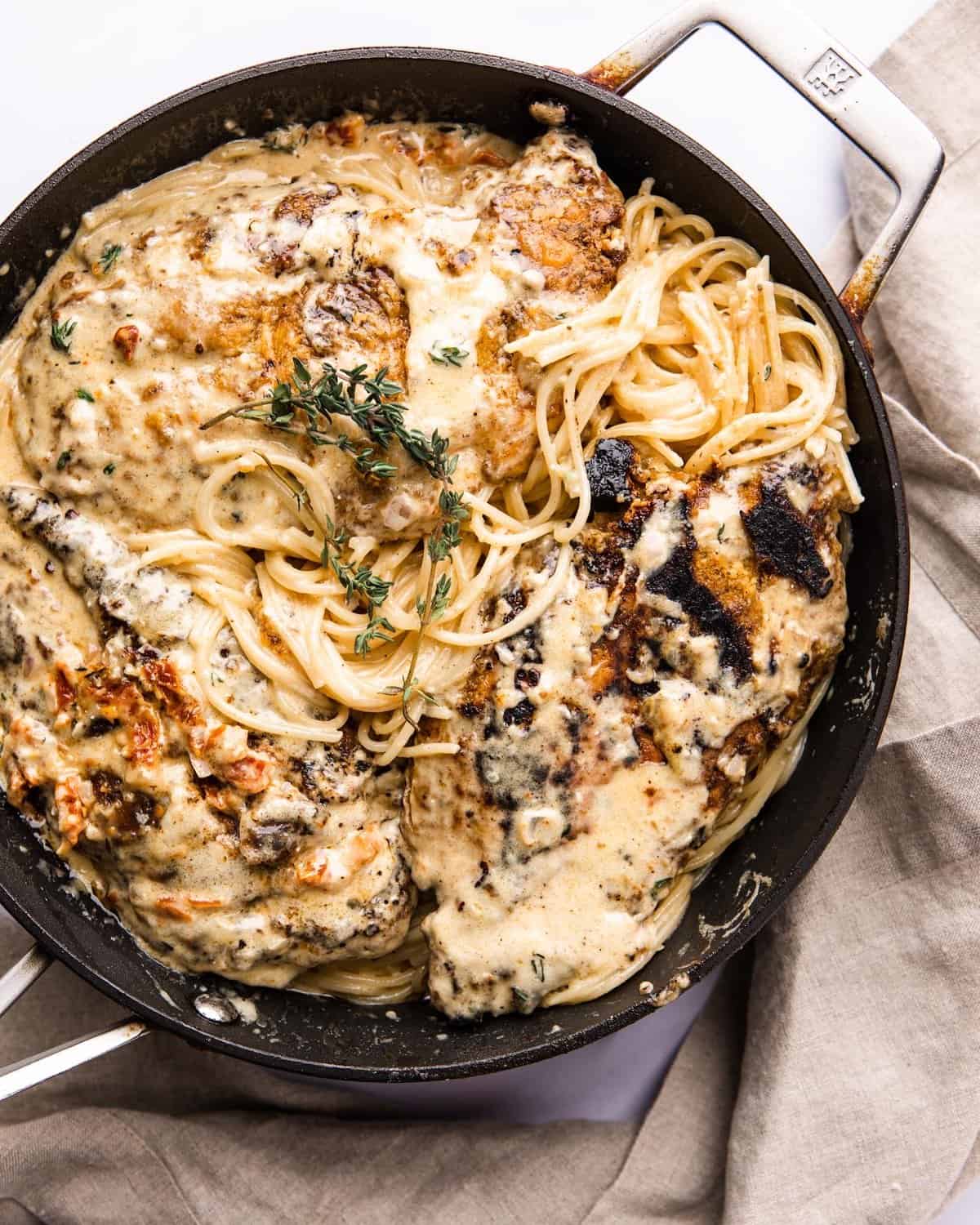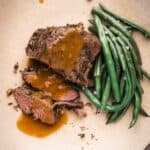Sous Vide Filet Mignon: The Key to Restaurant-Quality Steak at Home
Do you struggle to cook filet mignon to the perfect tenderness and juiciness? Say goodbye to tough and chewy steak with Sous Vide cooking! This technique uses precise temperature control to achieve flawless results every time. In this post, I will show you how to overcome these common cooking challenges at home so you can enjoy a restaurant-quality steak in the comfort of your home. In this post, I will also share my go-to red wine and herbs marinate that goes well when I Sous Vide my steak.

I was at a Christmas party hosted by my former boss at a co-worker’s house a few years ago; a private chef treated us to the most tender and perfectly cooked Filet Mignon. It surpassed any high-end steakhouse I had ever been to, and I was curious about the chef’s cooking methods. When I asked where he got the filets, he revealed that it wasn’t about the steak itself but rather how it was cooked. Intrigued, I asked if he used a special grill or technique, to which he shared his secret: Pre-cooking the steak using the French culinary technique known as “Sous Vide” and finishing it on the grill. From that moment on, I made it my mission to learn how to cook the best steak to match the quality of a steakhouse for my family.
Through time and practice, I’ve honed my skills in cooking steak, and now I’m thrilled to teach you how to cook Sous Vide Filet Mignon. What’s great is that this cooking technique can be used for various types of food, such as protein, vegetables, seafood, and desserts like Crème Brûlée, infused flavorings such as vanilla extract, and even pasteurizing eggs for food safety purposes. I even use this method to reheat Carbonara and Cacio e Pepe pasta without losing its texture and consistency. Once you master it, the culinary possibilities are limitless.
Recipe Snapshot
EASE: Easier to make than you might think
PROS: You will get your steak’s desired doneness every time.
CONS: Time-consuming and the equipment can be pricy.
WOULD I MAKE THIS AGAIN? Absolutely, especially when I want steak house-quality steaks.
What are some common issues home cooks face when cooking filet mignon using traditional methods?
If you’re a steak lover, you know that filet mignon is the holy grail of cuts. But like many inexperienced home cooks, they usually cook their steaks using traditional grilling and searing methods. They usually feel like cooking this steak to achieve the perfect restaurant level of tenderness and juiciness is impossible. Many of you might face the following issues each time:
Overcooking or undercooking –
You are always playing the guessing game and unsure when your filet mignon is cooked to your desired level of doneness. You tend to overcook or undercook your filet mignon and ruin your at-home steak dinners.
Uneven cooking –
Some steaks are burnt or charred due to high heat, yet some parts are still too rare.
Dry texture and flavorless –
When using traditional cooking methods, moisture is often lost due to evaporation, leading to dry and less flavorful food.
Your knowledge is limited –
You only rely on the traditional grilling or searing method; your steak always turns out chewy, dry, tough, and loses flavor.
Does this sound like what you are struggling with?
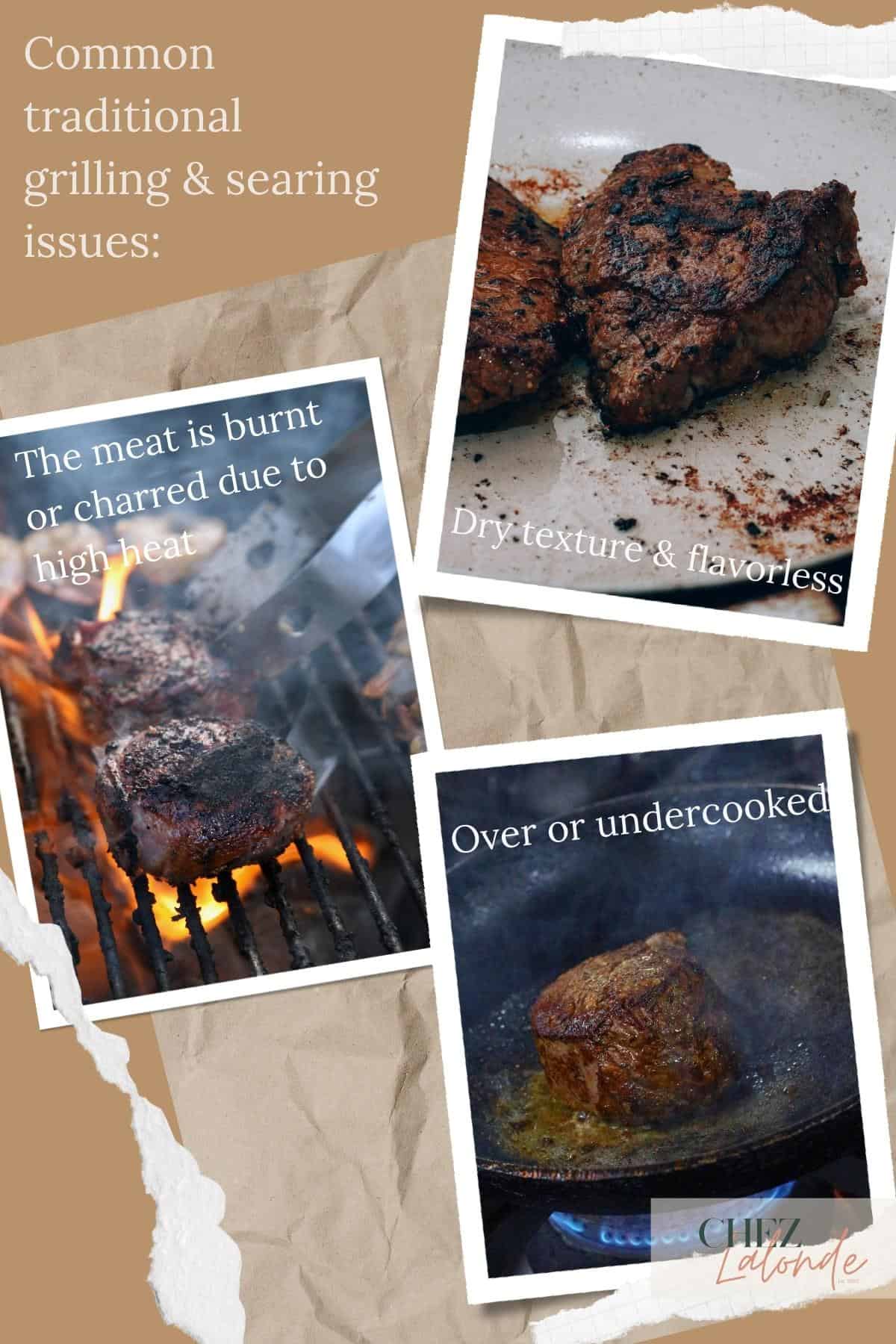
So you may wonder, “Exactly how do restaurants consistently achieve that perfect, juicy, and tender texture? What are their culinary secrets?”
Let me reveal the secret!
Sous Vide precision cooking is the secret to the perfectly cooked filet mignon.
What is Sous Vide?
Sous Vide, Pronounced “Sue – Vid,” is a French culinary term that means “Under Vaccum” in English.
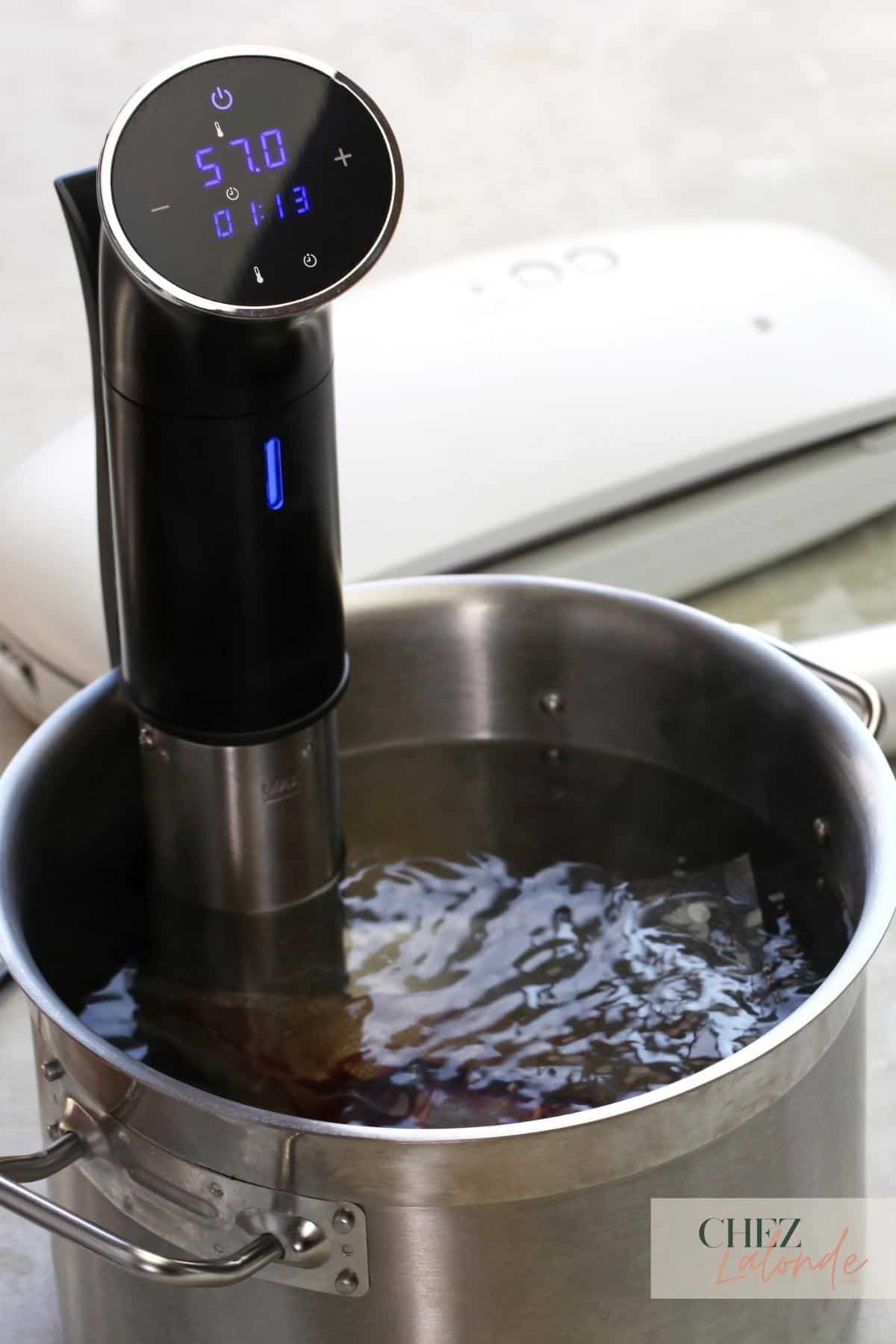
This unique French cooking technique was invented in the 70s by the talented French Chef Bruno Goussault. This cooking method is common among many high-end restaurants worldwide and is now gaining popularity in the home cooking world. Don’t let the non-familiar French word scares you. The technique is very simple. It is basically by placing food in a vacuum-sealed bag and then cooking it in a temperature-controlled water bath for an extended time. Besides steak or other protein, you can use this precision cooking method to make desserts, reheat food, cook vegetables, and even seafood. The results are excellent, and your food will never be overcooked.
Why is Sous Vide the key to achieving restaurant-quality steak at home?
Incorporating precision temperature in cooking is the key factor here. This innovative cooking method allows for precise temperature control, resulting in consistently cooked steak. The vacuum-sealed bags helps retain moisture and infuse various flavors of the marinades into the steak resulting in more flavorful meat. Most importantly, this method helps overcome the most common issues in traditional cooking, such as uneven cooking temperature, timing issues, and reduced marinating time.

What kind of ingredient can I Sous Vide with?
Various ingredients can be cooked using the Sous Vide method, such as meats, vegetables, fruits, eggs, fish, and desserts. To achieve the best results, I recommend adding a liquid or fat to the vacuum seal bag to ensure food is cooking evenly. To enhance the flavor of your dish, you can add herbs and spices to the liquid or fat. If you want to take the flavor to another level, adding red wine could deepen the overall flavor. By experimenting with different ingredients, you can find the perfect combination to enhance the taste of your meal.
What are some benefits of using the Sous Vide precision cooking methods?
- Temperature control: It allows you to set a specific temperature and maintains consistency throughout the cooking process.
- Evenly cooking: This cooking method ensures that your food is cooked evenly and no hot or cold spots can affect the texture and taste of your food.
- Control the doneness level: Since the temperature is maintained precisely, the food is always cooked to the desired doneness. You don’t have to worry about overcooking or undercooking your food.
- Consistent results: You can achieve the same results every time you cook. This makes the sous vide method perfect for cooking delicate foods like fish or steak that require a specific internal temperature to be cooked perfectly.
- In-depth flavor: With Sous Vide cooking, the food is vacuum-sealed in a bag, which not only helps prevent moisture loss but also allows the food to be infused with various flavors such as herbs, spices, and marinades.
What are some drawbacks to consider when using the Sous Vide cooking method?
- Initial equipment cost: The Sou Vide machine can be expensive, especially for some well-known brands; no other kitchen equipment can substitute it and create the same result.
- Time-Consuming: Sous Vide cooking is a slower process than traditional cooking methods and can take several hours to cook food properly.
- Lack of Maillard Reaction: Sous Vide cooking doesn’t produce the same Maillard reaction as traditional cooking methods; since the food is cooked in a sealed bag, it doesn’t develop the same type of crust or sear the traditional cooking method does.
- Texture Changes: While Sous Vide cooking results in tender and juicy meat, some people may find the texture too soft or mushy.
- Feeling intimidated by this method: Learning the Sous Vide technique may take some time, especially if you’re accustomed to searing, grilling, or using an oven. Initially can seem daunting when you’re unfamiliar with this cooking method.
How to choose the best Sous Vide machine for home use?
The best Sous Vide machine and gear will depend on your budget and needs. Various options are available, from affordable immersion circulators to more expensive countertop models. While commercial precision cookers can cost over $1000, smaller versions are becoming more popular and affordable. The Anova Sous Vide precision cooker is one of the most popular and affordable options and the one I use and recommend for home use.
It’s worth exploring other brands too. When searching for the perfect machine, consider the following features:
- User-friendly interface
- Temperature range
- Ability to connect to Wifi
- Timer settings
Additionally, accessories, like a Sous Vide container, lid, clips, and rack, can enhance your Sous Vide experience. With some research, you’ll be able to find the best Sous Vide machine and gear to create mouth-watering meals.
What Makes Anova Precision Cooking Machine So Great?
The convenience of Cloud Cooking technology –
One of the most significant advantages of the Anova precision cooker is its Wifi connectivity and app. With the app, you can easily set up the cooker and start cooking whenever you’re ready without being present in the kitchen.
Safer and More Efficient than Traditional Cooking –
Sous Vide precision cooking is more consistent, efficient, and safer than conventional cooking methods. The precise temperature control ensures that your food is cooked evenly and to a safe internal temperature every time.
Takes Up Minimal Counter Space –
The Anova precision cooker is a small, round cylinder that can be easily stored without taking up much counter space. This means you don’t have to sacrifice extra space in your kitchen to enjoy the benefits of Sous Vide cooking.
It is time to learn how to make Sous Vide Filet Mignon.
Are you ready?
Ingredients for making “Red wine & herbs marinade.”
Olive Oil – Oil helps add moisture and richness to the steak as it cooks.
Dry Red Wine – The wine can help to tenderize the meat and infuse it with rich flavors that complement the natural taste of the steak. I love to use Merlot or Chianti.
Aromatics – Minced garlic, diced yellow onion, diced shallots – As the steak cooks in the sealed bag with the aromatics, the flavors infuse into the meat, creating a delicious, rich taste.
Dried herbs – Parsley, oregano, and thyme – add a pleasant fragrance to the steak that can complement its taste, giving the steak a more complex and rich flavor profile.
Sea salt and black pepper – Adding salt and pepper to sous vide steak is essential to enhance flavor and tenderize the meat. The low cooking temperature in sous vide doesn’t allow for a Maillard reaction, but salt helps to develop the taste and retain moisture in the steak.
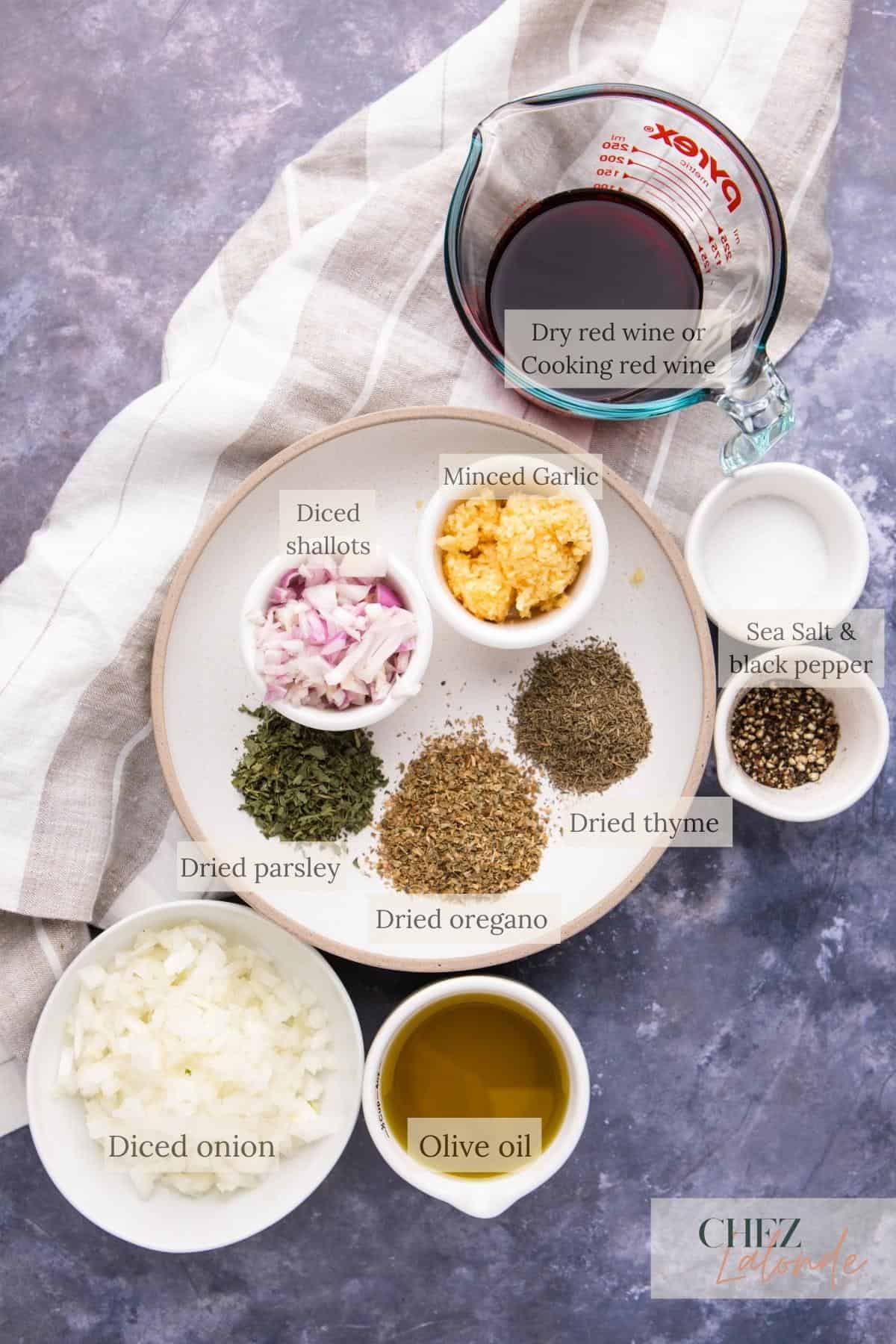

How to Sous Vide a Steak – Step by Step
Sous Vide cooking is surprisingly easy too. Here’s my tried-and-true five-step process for cooking the perfect Sous Vide steak at home every time:
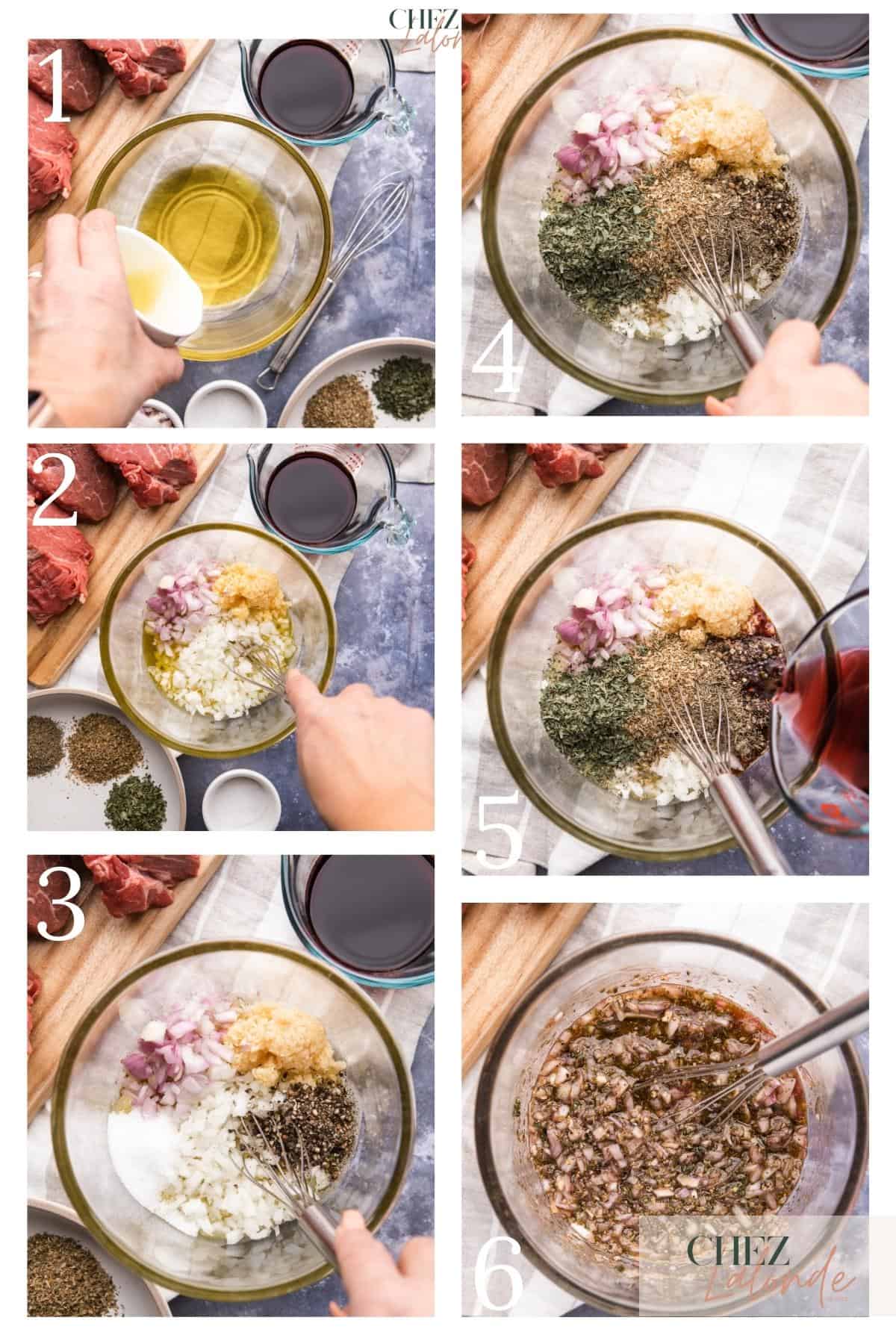
- Step 1 – Season your steak with preferred seasonings. The simple method is to use olive oil or unsalted butter, sea salt, black pepper, and herbs. Or you can create a marinade to add flavor to your steaks.
- Step 2 – Place your seasoned steak in a food-safe plastic bag and vacuum-seal it to remove all the air.
- Step 3 – Preheat your Sous Vide precision cooker to your desired temperature (for a medium-rare steak, set the temperature to 138°F). I have included a chart below for your reference.
- Step 4 – Once the water has reached the right temperature, immerse the bagged steak in the water bath and cook it for a minimum of 1 hour, depending on the thickness of your steak. Do not cook the steak for more than 4 hours.
- Step 5 – After cooking, remove the steak from the bag and finish it by searing it in a hot skillet or grill for 2 minutes on each side to get that beautiful grill mark and crust.

How to serve your filet mignon?
Filet Mignon is a top-quality beef cut; it is best enjoyed cooking to medium rare. I enjoy preparing this dish for special occasions such as date nights or gatherings with friends. Typically, I serve my filet with my favorite side dishes such as creamy mashed potatoes, Maple roasted rainbow carrots, or garlic stir-fried French beans. However, when entertaining larger groups of family and friends at home, I often slice the steak into bite-size pieces and present it as a buffet-style dish, which adds a fun, informal touch. Guests can serve themselves as many pieces as they desire, making the meal less formal and fun.
Sous Vide Cooking 101 – Tips and tricks
How should I prepare my filet mignon before cooking?
When purchasing pre-cut filet mignon at your local supermarket, choosing the appropriate thickness for Sous Vide cooking is essential. I recommended using filet cuts at least 2 inches thick for best results when using sous vide. Steaks less than 2 inches thick may not be suitable for this cooking method as they can become too mushy. Alternatively, you can purchase the whole beef tenderloin and cut it at home. Costco is the most economical place to get the whole beef tenderloin piece.
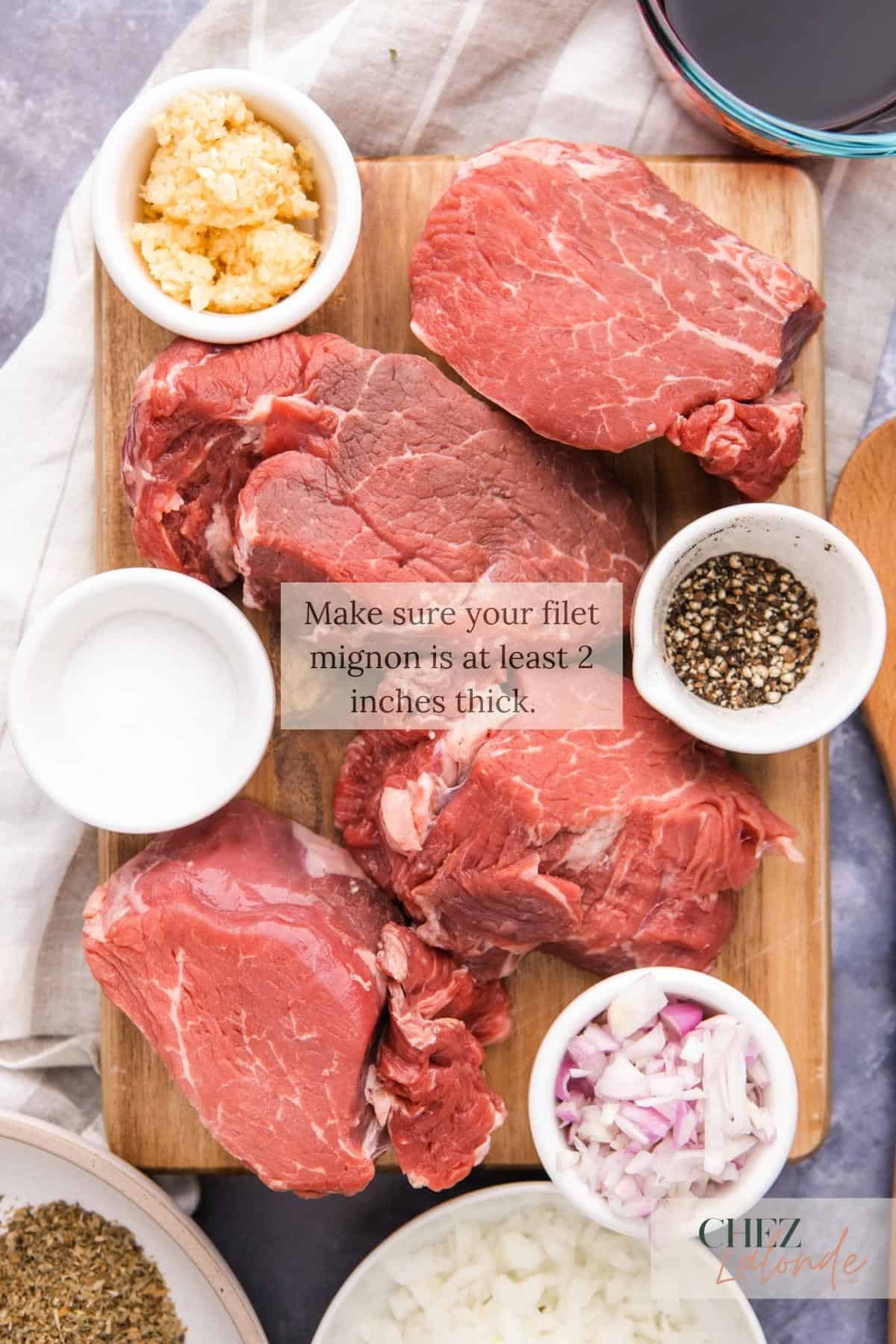
How Long Does It Take to Sous Vide Filet Mignon?
When cooking filet mignon with this precision cooking method, I recommend Sous Vide for at least one hour, but you can also cook it for up to four hours to enhance the flavor with the marinade.
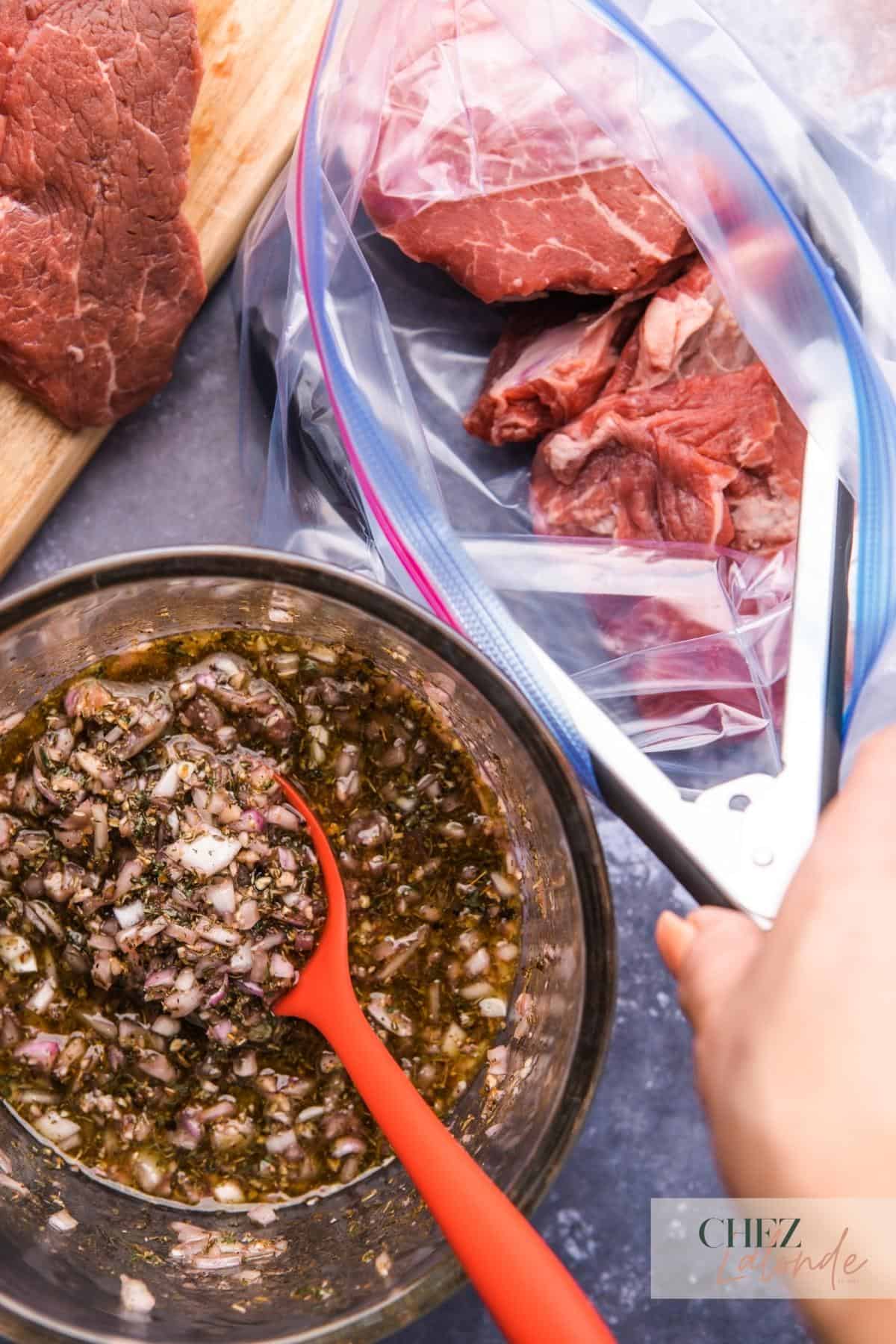
Do I need to season or marinate the steak a day ahead?
While marinating your steak in advance can add extra flavor, it’s unnecessary when using Sous Vide cooking. The extended cooking time and sealed bag allow the meat to soak up any flavors from the marinade during the cooking process, resulting in a juicy and delicious steak without the extra prep time.
How to control the overall doneness?
To control the doneness when Sous Vide a steak, you need to set the temperature of the water bath to the desired internal temperature. Here is a chart that I created for easy reference. Now you can decide how you like your filet mignon to be cooked.
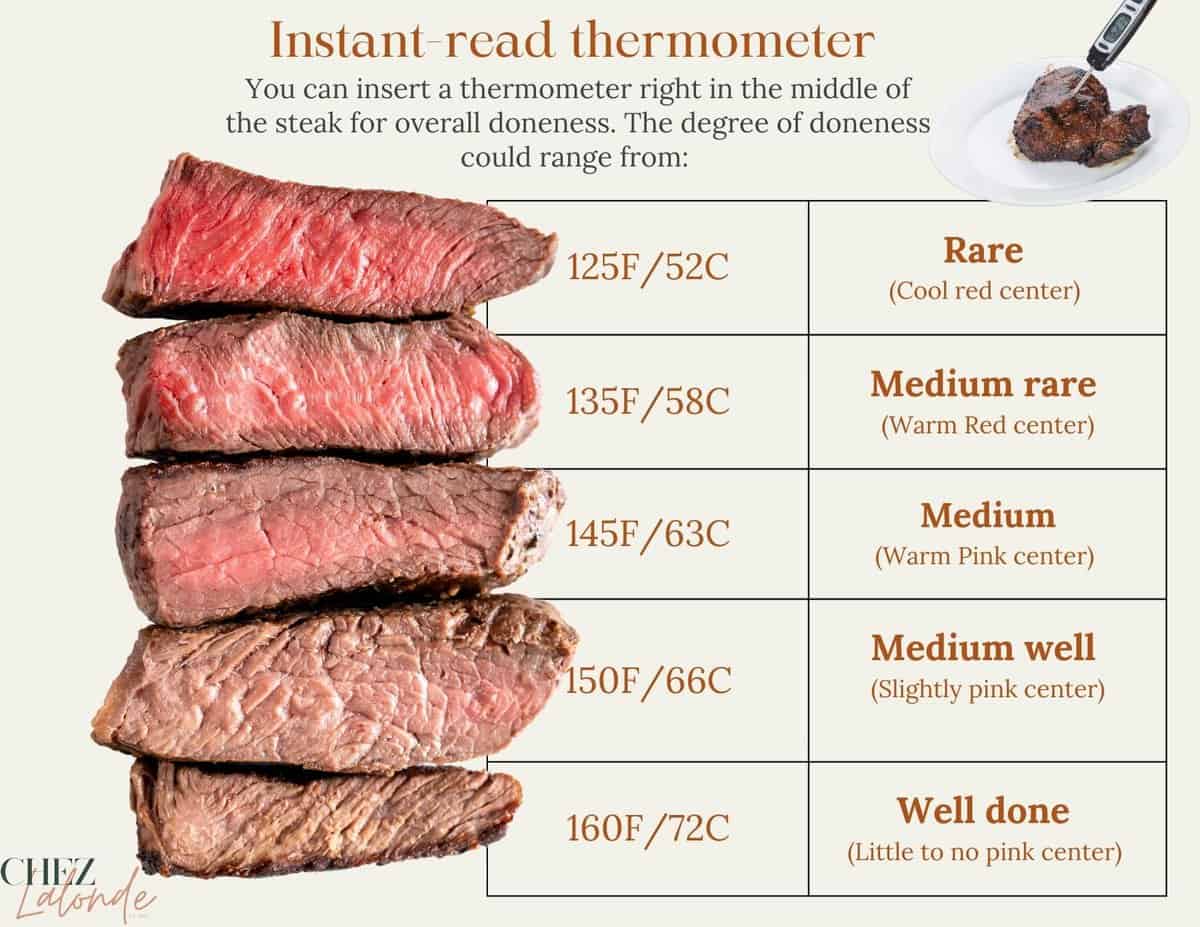

How to ensure the Ziploc bag is sealed without a Vacuum Sealer?
You can use the water displacement method to remove air from the Ziploc bag before cooking Sous Vide. It involves placing the food inside the bag, sealing it most of the way, then slowly submerging it in a water bath container; the heat from the water allows it to push the air out of the bag. The bag is then sealed completely, and the food can be cooked in a water bath without any air pockets, which ensures even cooking and eliminates the risk of the bag floating to the surface.
What other cooking techniques should I be aware of when cooking steak with this method?
Resting your steak after searing is a crucial step. Letting it rest allows the juice to redistribute evenly. By missing this step, your steak can have a dry and chewy texture.
How to Reheat Sous Vide Filet Mignon?
Reheating Sous Vide steak can be tricky and affect the texture and flavor if not done correctly. However, you can refrigerate or freeze your cooked steaks for later use. You need to first bring it to room temperature before refrigerating it. To preserve the tenderness and moisture, you should reheat the steak using the same Sous Vide technique but set the temperature 10 to 15 degrees lower than the original cooking temperature. This will help maintain the quality of the steak when reheated. I suggest avoiding reheating the steak in the microwave as it will overcook and become tough and chewy.

Substitutions and variation tips

Use Ziploc Bag –
Ziploc bags are a great alternative if you don’t have a vacuum seal machine. Removing as much air as possible from the bag before submerging it in the water bath ensures your food is evenly cooked. You can do this by slowly immersing the bag in the heated water, allowing air to escape naturally. Once the air is removed, zip up the bag and use a document clip to secure it to the edge of the pot. This method works well if the bag doesn’t float on the water.
Use a regular soup pot –
You don’t need fancy equipment for Sous Vide cooking. Instead of using a professional Sous Vide cooking container, you can use a regular soup pot that is deep and spacious enough to cook your steaks in. I use a 12-Qt, or 16-Qt pot at home for my Sous Vide cooking, and it works perfectly fine.
No Lids, No Problem –
Maintaining a constant temperature without a lid can be challenging when using a precision cooking machine. However, a simple solution to this problem is by using Sous Vide cooking balls. My husband discovered this inexpensive and effective method to prevent heat loss. All you need to do is pour enough balls to cover the surface of the water bath. This ensures that the temperature remains consistent throughout the cooking process.
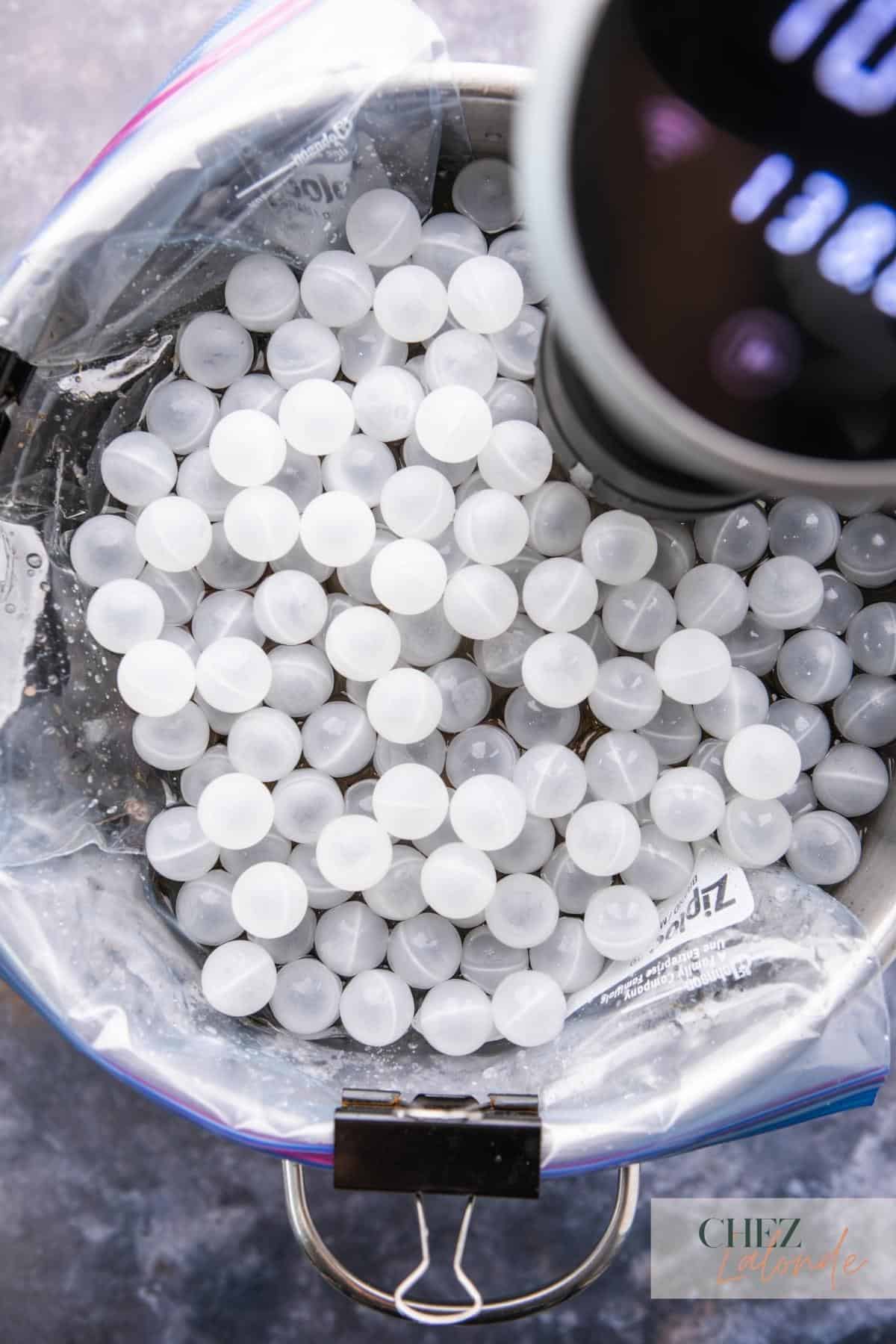
Follow the cooking time and temperature guide –
Remember that different ingredients require different cooking temperatures and times. I like to check out the Sous Vide cooking guide on SousVideSupreme.com to know how long and at what temperature to cook different ingredients. It’s super helpful and takes the guesswork out of cooking.
For even more Sous Vide recipe ideas, you may like these:

FAQs about Sous Vide cooking :
Are you ready to try out this unique French cooking technique?
By now, you’ve discovered all the secrets to sous vide cooking and the incredible results it can produce, especially regarding steak. The precise temperature control and infusion of flavors make it the ideal method for achieving restaurant-quality steak at home. Don’t be intimidated by this technique – invest in a Sous Vide precision cooking machine, gather your favorite ingredients, and get creative with your cooking times and seasonings. With some experimentation and patience, you can enjoy a delicious, mouthwatering steak that will amaze your guests.
So, what are you waiting for? Give it a try, and enjoy the incredible results! Let me know how it turns out in the comments below. And if you enjoyed this recipe, check out our other entrée recipes for even more mouth-watering dishes to try at home. Happy cooking!

Sous Vide Filet Mignon: The Key to Restaurant-Quality Steak at Home
- Total Time: 0 hours
- Yield: 4
Description
Tired of tough and chewy filet mignon? Sous vide is here to save the day. Achieve perfect tenderness and juiciness every time with precise temperature control methods. Learn how to overcome common pain points of cooking filet mignon at home and enjoy restaurant-quality steak in your own kitchen. Check out our recipe for making your red wine and herbs-infused steak.
Ingredients
4 Filet mignon (6 to 8 oz each)
1/2 Cup olive oil
1/4 Cup dry red wine (Melot or Chianti)
1/2 Cup yellow onion (Diced)
1 Diced shallot
2 Tablespoons of minced garlic
1 Tablespoon of dried parsley
1 Tablespoon of dried oregano
1 Tablespoon of dried thyme
Sea Salt and black pepper to taste
Instructions
- Step 1 – Begin by removing your steaks from the packaging, rinsing them under running water, and patting them dry with paper towels. Then, place them on a baking sheet.
- Step 2 – Dice the aromatics, such as garlic, onion, and shallot. Next, in a mixing bowl, combine olive oil, red wine, aromatics, and dried herbs, salt, and pepper to create a well-mixed seasoning.
- Step 3 – Place the filets in a Ziploc or vacuum-sealed bag and pour the oil mixture into each bag. To ensure even distribution, use a spoon to assist you in spreading the mixture evenly.
- Step 4 – Fill a large soup pot or a Sous Vide container about three-quarters full with water. Insert your precision cooking machine into the container and set the cooking temperature to your desired doneness.
- Step 5 – You don’t have to wait for the water bath to reach your desired temperature before putting your sealed bag of steak in. The machine will slowly bring up to the set temperature. Clip the bag to the pot’s side and let it cook for at least one hour and up to four hours.
- Step 6 – When done cooking, remove your bag of steak from the water bath. Take your steaks out of the sealed bag. Heat your grill or frying pan over medium-high heat. Sear and brown each side of the steak for about 2 minutes. You can serve your steak with your preferred side dishes.
Notes
- You can use Ziploc or vacuum-sealed bag to cook your steak.
- The length of Sous Vide time depends on the thickness of the steak and how you like the doneness. It usually takes 1 hour to a maximum of 4 hours.
- Use the temperature chart to decide how you like your filet mignon to be cooked.
- Prep Time: 15 minutes
- Cook Time: 1 hour to 4 hours
- Category: Entree
- Method: Sous Vide
- Cuisine: American
Keywords: Sous Vide, Steak, Filet Mignon, restaurant style

